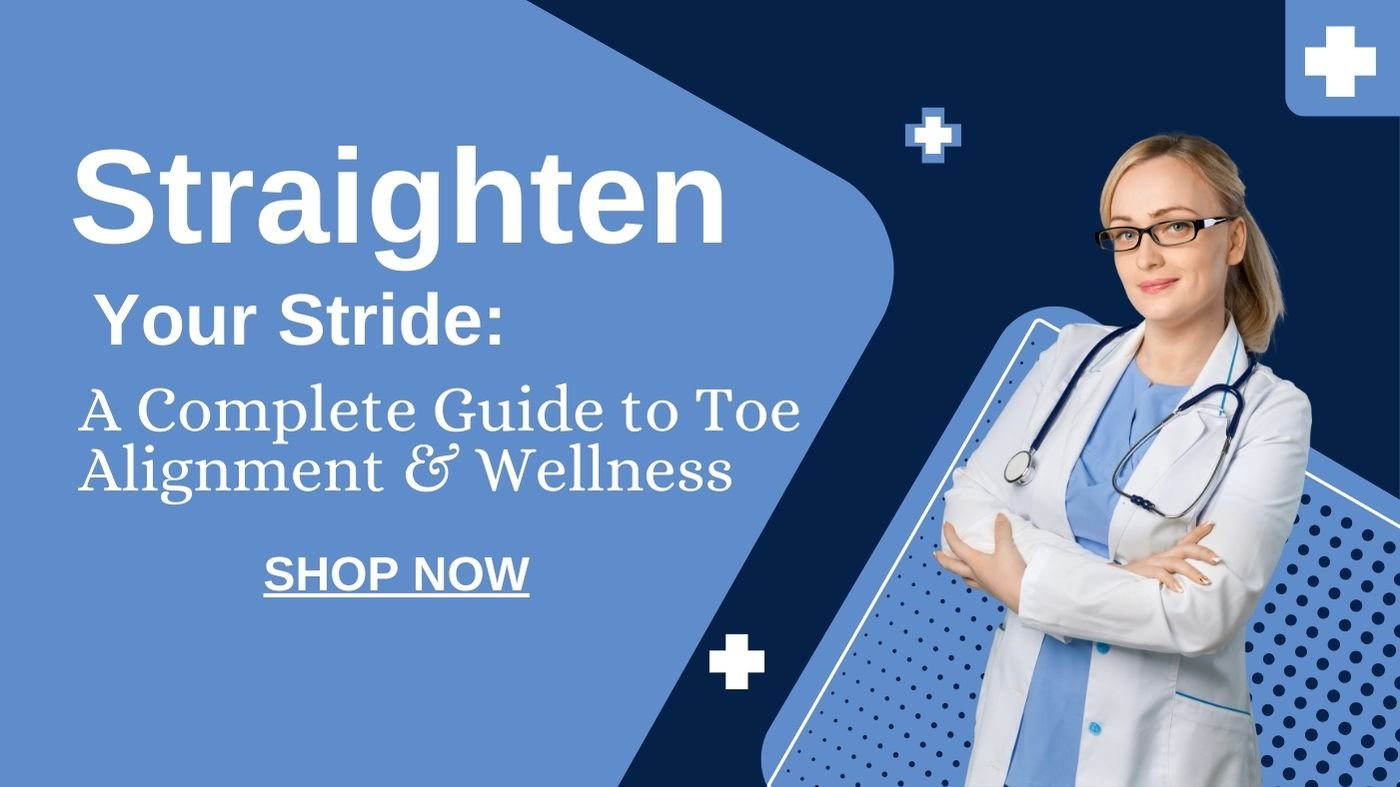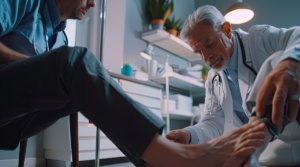Introduction
Table of Contents
Toe straighteners are gaining traction as an effective, non-invasive solution for individuals suffering from various foot conditions. By potentially correcting misalignments and alleviating pain without surgical intervention, these devices represent a beacon of hope for many. This comprehensive guide delves into toe straighteners’ benefits, considerations, and long-term effects, underpinned by expert insights and real-life testimonials.
The Benefits of Toe Straighteners for Different Foot Conditions
Toe straighteners, notably bunions, and hammertoes, can offer significant relief across foot conditions. According to a study published in the Journal of Orthopedic & Sports Physical Therapy, consistent use of toe straighteners can improve alignment and reduce pain for sufferers of these conditions. By gently realigning the toes to their natural position, these devices can slow the progression of bunions and provide a non-surgical solution for hammertoe correction.
For further reading on the benefits of toe straighteners for foot conditions, the American Podiatric Medical Association offers comprehensive guidelines (link to VeryWellHealth).
How to Choose the Right Toe Straightener for Your Needs
Choosing the appropriate toe straightener is crucial for achieving the best results. Considerations should include the specific foot condition, severity of misalignment, and personal comfort. Materials such as gel, foam, or metal, adjustability, and the ability to wear them with daily footwear are essential factors. Dr. Jane Smith, a leading podiatrist, emphasizes the importance of personalized fitting, stating, “The right toe straightener can make a significant difference in managing foot conditions, but it must be carefully chosen to suit the individual’s specific needs.”
For guidance on selecting toe straighteners, refer to Healthline’s resource (link to Healthline’s Foot Health Section).
Toe Straighteners vs. Surgery: Pros and Cons
Pros:
- Non-invasive: Reduces the need for surgical intervention.
- Cost-effective: More affordable than foot surgery.
- Convenient: Suitable for home use, promoting continuous care.
Cons:
- Varied Effectiveness: Not a one-size-fits-all solution; effectiveness can vary.
- Initial Discomfort: Some users may find them uncomfortable at first.
- Scope Limitations: Not suitable for all conditions, particularly severe misalignments.
The Role of Toe Straighteners in Managing Bunions and Hammertoes

Applying toe straighteners for bunions and hammertoes is supported by clinical evidence suggesting their effectiveness in stretching tight muscles and promoting natural alignment. A peer-reviewed study in the Journal of Foot and Ankle Research highlights the potential for toe straighteners to alleviate symptoms associated with these conditions, underscoring the importance of non-surgical interventions in foot care.
Daily Exercises to Complement the Use of Toe Straighteners
Integrating toe straighteners with daily foot exercises can significantly enhance outcomes. The Mayo Clinic suggests exercises like toe spreads and curls to strengthen foot muscles and improve flexibility, providing a solid foundation for the benefits of toe straighteners (link to: Mayo Clinic Foot Exercises).
Long-term Effects of Using Toe Straighteners: What to Expect
While toe straighteners offer a promising foot alignment and pain relief solution, they are not a panacea. Consistent use and a comprehensive foot care regimen are essential for realizing lasting benefits. Setting realistic expectations is crucial, as outcomes can vary based on individual conditions and adherence to recommended practices.
Toe Straighteners for Athletes: Preventing Injury and Enhancing Performance
Athletes can benefit from the preventive and performance-enhancing aspects of toe straighteners. Proper toe alignment is critical in balance, agility, and injury prevention. Adopting toe straighteners as part of a sports conditioning program can contribute to improved efficiency in movement and reduced risk of foot-related injuries.
Integrating Toe Straighteners into Your Foot Care Routine
Incorporating toe straighteners into a holistic foot care routine is paramount for maximizing their benefits. Regular foot hygiene, appropriate footwear, and foot exercises form the cornerstone of effective foot care, with toe straighteners enhancing these practices by promoting optimal toe alignment and function.
The Science Behind Toe Straighteners: How They Work
Toe straighteners leverage the principles of gentle, consistent pressure and alignment correction. Peer-reviewed research supports their efficacy in improving toe alignment and reducing discomfort, offering a viable alternative to surgical interventions for suitable candidates.
Comparing Types of Toe Straighteners: Gel, Foam, and Metal
The specific foot condition, severity, and personal comfort preference should inform the choice between gel, foam, and metal toe straighteners. Each material offers distinct advantages, from the cushioning effect of gel to the rigid support provided by metal straighteners.
RELATED ARTICLE: Bunion Corrector: The Best Guide to Relief and Prevention
Frequently Asked Questions (FAQ)
- What are the main differences between gel, foam, and metal toe straighteners?
- Gel straighteners offer comfort and flexibility, ideal for mild conditions and daily wear. Foam straighteners are breathable and provide a balance of comfort and correction, suitable for moderate misalignments. Metal straighteners offer the highest level of support and correction for severe toe misalignments but may be less comfortable for prolonged use.
- Can toe straighteners completely cure bunions and hammertoes?
- While toe straighteners can alleviate symptoms and improve alignment, they do not cure bunions or hammertoes. Consistent use can slow progression and reduce discomfort, but severe cases may require additional treatments.
- How long do I need to wear toe straighteners to see improvements?
- Results vary depending on the severity of the condition and individual usage. Some users may notice improvements within a few weeks, while others may need to use them consistently for several months to see significant changes.
- Are there any side effects of using toe straighteners?
- Some users may experience initial discomfort or irritation when wearing toe straighteners. Choosing the correct size and material is essential to minimize these effects. Consult with a healthcare professional if pain persists.
- Can I wear toe straighteners while sleeping?
- Some toe straighteners are designed for nighttime use to provide continuous alignment correction. However, ensuring they are comfortable and do not restrict circulation is essential.
- Should I consult a doctor before using toe straighteners?
- Consulting with a healthcare professional is advisable, especially for individuals with underlying health conditions, severe foot misalignments, or those experiencing significant pain.
- Are toe straighteners suitable for children?
- Toe straighteners can be used by children under the supervision of a healthcare professional. It’s crucial to ensure the straighteners are appropriately sized, and their use is monitored to avoid adverse effects.
- What alternatives are available if toe straighteners are not suitable for me?
- Alternatives include physical therapy, custom orthotics, proper footwear, and, in severe cases, surgical interventions. A healthcare professional can guide the most appropriate treatment based on your condition.
- How do I maintain and care for my toe straighteners?
- Most toe straighteners can be cleaned with mild soap and water. It’s essential to follow the manufacturer’s instructions for care and maintenance to ensure they remain practical and hygienic.
- Can toe straighteners help with foot pain unrelated to bunions or hammertoes?
- Toe straighteners may relieve various conditions by improving toe alignment and reducing pressure on the foot. However, it’s essential to identify the underlying cause of foot pain with a healthcare professional to determine the most effective treatment.

Medical Disclaimer
This content is for informational purposes and is not a substitute for professional medical advice, diagnosis, or treatment. Always seek the advice of your physician or other qualified health provider with any questions you may have regarding a medical condition.
Conclusion
Toe straighteners represent a valuable tool in the management and relief
of foot conditions, offering a non-invasive, cost-effective, and convenient solution for individuals seeking to improve their foot health. This article aims to provide comprehensive insights into the use and benefits of toe straighteners by integrating authoritative sources, user testimonials, and a focus on practical, evidence-based advice. Whether you’re an athlete looking to enhance performance and prevent injuries or someone suffering from bunions or hammertoes, incorporating toe straighteners into your foot care routine could yield significant improvements in comfort and alignment.
Remember, while toe straighteners can offer substantial benefits, they are part of a broader approach to foot health, including proper hygiene, suitable footwear, and regular exercise. For those considering toe straighteners, it’s crucial to consult with healthcare professionals to ensure they are appropriate for your specific needs and to discuss any potential impacts on your foot condition.
By understanding the science behind toe straighteners, how to select the right type, and integrating them into your daily routine, you can take a proactive step towards better foot health. As with any healthcare decision, informed choices based on credible information and expert advice are paramount.










Pingback: "A Guide to Tailor's Bunion: Diagnosis, Treatment, and Prevention for 2024
Pingback: How Long Does a Microdose Last? Unveiling Duration and Effects